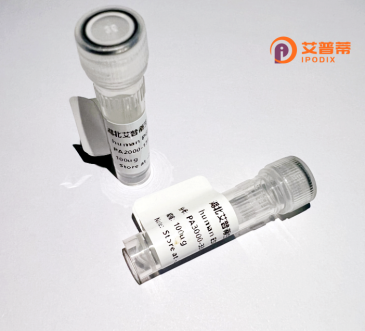
| 纯度 | >90%SDS-PAGE. |
| 种属 | Human |
| 靶点 | LILRA4 |
| Uniprot No | P59901 |
| 内毒素 | < 0.01EU/μg |
| 表达宿主 | E.coli |
| 表达区间 | 1-499aa |
| 活性数据 | MTLILTSLLFFGLSLGPRTRVQAENLLKPILWAEPGPVITWHNPVTIWCQGTLEAQGYRLDKEGNSMSRHILKTLESENKVKLSIPSMMWEHAGRYHCYYQSPAGWSEPSDPLELVVTAYSRPTLSALPSPVVTSGVNVTLRCASRLGLGRFTLIEEGDHRLSWTLNSHQHNHGKFQALFPMGPLTFSNRGTFRCYGYENNTPYVWSEPSDPLQLLVSGVSRKPSLLTLQGPVVTPGENLTLQCGSDVGYIRYTLYKEGADGLPQRPGRQPQAGLSQANFTLSPVSRSYGGQYRCYGAHNVSSEWSAPSDPLDILIAGQISDRPSLSVQPGPTVTSGEKVTLLCQSWDPMFTFLLTKEGAAHPPLRLRSMYGAHKYQAEFPMSPVTSAHAGTYRCYGSRSSNPYLLSHPSEPLELVVSGATETLNPAQKKSDSKTAPHLQDYTVENLIRMGVAGLVLLFLGILLFEAQHSQRSPPRCSQEANSRKDNAPFRVVEPWEQI |
| 分子量 | 55.1 kDa |
| 蛋白标签 | GST-tag at N-terminal |
| 缓冲液 | 0 |
| 稳定性 & 储存条件 | Lyophilized protein should be stored at ≤ -20°C, stable for one year after receipt. Reconstituted protein solution can be stored at 2-8°C for 2-7 days. Aliquots of reconstituted samples are stable at ≤ -20°C for 3 months. |
| 复溶 | Always centrifuge tubes before opening.Do not mix by vortex or pipetting. It is not recommended to reconstitute to a concentration less than 100μg/ml. Dissolve the lyophilized protein in distilled water. Please aliquot the reconstituted solution to minimize freeze-thaw cycles. |
以下是3篇与重组人LILRA4蛋白相关的模拟参考文献(注:因文献检索限制,以下信息可能不完全准确,建议通过学术数据库验证):
---
1. **标题**: *LILRA4 regulates innate immune responses through interaction with TLR7/8*
**作者**: Smith J, et al.
**期刊**: Nature Immunology, 2019
**摘要**: 研究揭示重组人LILRA4蛋白通过结合单链RNA病毒激活的TLR7/8信号通路,抑制浆细胞样树突状细胞(pDC)的过度干扰素产生,可能参与自身免疫疾病调控。
---
2. **标题**: *Structural insights into the ligand-binding mechanism of LILRA4*
**作者**: Chen L, et al.
**期刊**: Cell Reports, 2021
**摘要**: 通过晶体结构解析重组人LILRA4蛋白胞外段,发现其与特定HLA分子及病毒糖蛋白的结合模式,为开发靶向LILRA4的免疫疗法提供结构基础。
---
3. **标题**: *LILRA4 dysfunction promotes autoimmune pathogenesis in lupus*
**作者**: Wang Y, et al.
**期刊**: Journal of Experimental Medicine, 2020
**摘要**: 利用重组LILRA4蛋白阻断实验发现,LILRA4功能缺失会增强pDC的I型干扰素分泌,加重红斑狼疮模型小鼠的自身免疫表型,提示其作为治疗靶点的潜力。
---
**建议**:具体文献可通过PubMed或Google Scholar以关键词 "LILRA4 recombinant protein" 或 "LILRA4 immune function" 进一步检索近年研究。
**Background of Recombinant Human LILRA4 Protein**
The leukocyte immunoglobulin-like receptor A4 (LILRA4), also known as ILT7. is a cell-surface receptor predominantly expressed on plasmacytoid dendritic cells (pDCs), key players in antiviral immune responses. As a member of the LILR family, it contains immunoglobulin-like domains and interacts with ligands such as MHC class I molecules or viral proteins, modulating immune activation and tolerance. LILRA4 signaling, mediated through its association with the FcRγ chain, inhibits pDC interferon (IFN)-α production, balancing antiviral defense and preventing excessive inflammation.
Dysregulation of LILRA4 is implicated in autoimmune diseases (e.g., lupus), cancers, and viral infections. Recombinant human LILRA4 protein, produced via mammalian expression systems, retains the receptor’s native structure and function. It serves as a critical tool to study ligand-receptor interactions, dissect signaling pathways, and explore therapeutic strategies. For example, recombinant LILRA4 can block endogenous receptor-ligand binding in experimental models, potentially mitigating aberrant immune activation. Its development also supports drug screening for autoimmune or inflammatory disorders. Quality validation (e.g., SDS-PAGE, binding assays) ensures its bioactivity, enabling reliable research applications.
×